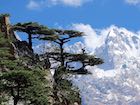
Bonsai-like trees in the Kalpa Valley, India, Oct-2019 [Gaurav Verma, 2019.12.03, Facebook post].
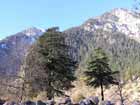
Trees in Chitral Gol National Park, Pakistan [Vladimir Dinets, 2004.10].
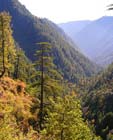
Trees in Chitral Gol National Park, Pakistan [Vladimir Dinets, 2004.10].
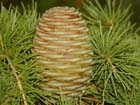
Cone and foliage of an ornamental specimen in Seattle [C.J. Earle, 2001.10].

Pollen cone on an ornamental specimen in Seattle [C.J. Earle, 2001.10].
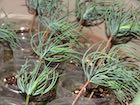
Recently germinated seedlings [Gaurav Verma, 2020.03.07, Facebook post].
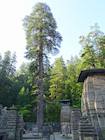
The giant Cedrus deodara at an ancient temple complex in the Jageshwar Valley, India (elev. 1870 m). The girth of the tree is between 9-10 m [Gaurav Verma, 2019.04].
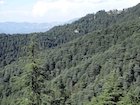
Pure forest of mature/old Cedrus deodara in Chail wildlife sanctuary, India [Gaurav Verma, 2019.07.11, Facebook post].

Old trees on a steep, rocky slope in the Kalpa Valley, India, elev. 2960 m, Oct-2019 [Gaurav Verma, 2019.12.03, Facebook post].

Conservation Status

Cedrus deodara
(Roxb. ex D. Don) G. Don 1830
Common names
देवदार [Hindi]; أرز دوداري [Arabic]; deodar, devdar, Himalayan cedar; ヒマラヤスギ [Japanese].
Taxonomic notes
Syn: C. indica Chambray; Cedrus libani var. deodara Hook. (Vidakovic 1991).
Description
"A tree up to 50 m high and up to 3 m in diameter. Crown conical when young, with drooping leader and branches drooping at the end (Fig. 67), older trees rounded. Branches horizontally arranged, and end of the shoots pendulous. One-year shoots densely pubescent. Needles blue-green, about 30 in a cluster, 3-5 cm long, acuminate. Flowers appear in September and October. Cones solitary or in pairs. ovate or barrel-shaped. 7-10 cm long, 5-6 cm wide, rounded at the apex, bluish when young, reddish-brown when ripe; maturing from September to November; the seed is shed from September to December; seed scales 5-6 cm wide, usually glabrous on the upper side. Seed about 17 mm long, about 6 mm wide; wing large, light brown" (Vidakovic 1991). See García Esteban et al. (2004) for a detailed characterization of the wood anatomy.
Distribution and Ecology
India and Pakistan: W Himal and S slopes of the Hindu Kush (Silba 1986, Vladimir Dinets e-mail 1998.01.02) at 1100-3000 m, "usually on silicate mother rocks. ... The best trees are found on deep, well-drained soils. High atmospheric moisture is favourable. It is tolerant to shade, but young trees are prone to injury from frosts and cold wind" (Vidakovic 1991). It is a component of the temperate forest, usually on north-facing valley slopes, where rainfall ranges from less than 1000 mm per year up to 2500 mm per year, mostly in the form of winter snow. In these forests C. deodara is associated with a wide array of conifers and some broadleaf trees. Species present may include Pinus wallichiana, Taxus baccata, Picea smithiana, Abies spectabilis, and Abies pindrow, as well as species of Quercus, Rhododendron, Acer, Corylus, Aesculus and Betula. At somewhat lower and drier (precipitation less than 1000 mm/year, mostly as snow) elevations it commonly occurs with Pinus gerardiana, Quercus ilex and Juniperus excelsa subsp. polycarpos (Bhattacharyya et al. 1988).
Distribution of Cedrus deodara based on observations and herbarium collections. Data sources include Conifers of the World, GBIF.org, and iNaturalist.org (accessed 2019.09.11).
Hardy to Zone 8 (cold hardiness limit between -12.1°C and -6.7°C) (Bannister and Neuner 2001).
Remarkable Specimens
Monumental Trees (2011) report, with photographs, a tree in habitat 14.5 meters in girth (approx. 460 cm dbh) and approximately 30 m tall. This is one of the largest trees in the Pinaceae. It occurs in Tolma, state of Uttarakhand, India. The photo shown here is of another large tree in India, for which I have no reliable measurement data. I have found no other records for trees in habitat. There are abundant records of ornamental specimens, a few of which are listed here.
| Country | DBH | Height | Source |
| Australia | 212 cm | 25 m | Andrew Tomkins 2014 |
| New Zealand | 130 cm | 28.5 m | R. VanWijngaarden 2013 |
| Italy (largest in Europe) | 245 cm | 45 m | Saro Sciuto 2016 |
| USA | 184 cm | 29.9 m | (Cowley 1998) |
| USA | 199 cm | 31.5 m | R. Van Pelt email 2024.06.02, a new measurement of the big tree on the east lawn at the Capitol in Sacramento. |
The oldest known specimen is a tree-ring sample with 900 rings reported by Bhattacharyya et al. (1988); they provide no further information. A cross-section displayed at the timber museum of F.R.I. Dehra Dun is 280 cm across with 704 rings (Robert Van Pelt e-mail 2004.02.04); Bhattacharyya et al. (1988) report this same sample, citing Gamble (1902), as having 660 rings. There is also a report of a tree-ring chronology covering 745 years; if based on living trees, this may include the oldest known living C. deodara (Yadav and Bhattacharyya 1992).
Ethnobotany
Deodar in general, and the Devdar Forest of Himachal Pradesh in particular, are sacred to the Hindu. This is also the national tree of Pakistan and the state tree of Himachal Pradesh.
This is an important timber tree in India. In the West, is widely planted as an ornamental in Europe (Vidakovic 1991) and the western U.S.
Two exploratory studies of dendrochronology by Bhattacharyya et al. (1988, 1992) found that samples from sites in India (Kashmir) and western Nepal provided long records, crossdated well, and contained significant variance attributable to climate. A variety of further studies have also been done, mostly by Bhattacharyya and Yadav.
Observations
Vladimir Dinets (email, 2004.11.14) reports that Kalam, in Pakistan's Swat Valley, has a large forest of C. deodara with some Picea smithiana and Pinus wallichiana. He adds that the only other place with a lot of Cedrus is Chitral Gol National Park, a much longer trip from Islamabad. See Dinets (2004) for further detail.
Remarks
"Deva" is the Sanskrit for "god" and "daru" for "tree", so the epithet deodara signifies the tree of the gods.
Citations
Bhattacharyya, A., V.C. LaMarche Jr., and F.W. Telewski. 1988. Dendrochronological reconnaissance of the conifers of northwest India. Tree-Ring Bulletin 48:21-30.
Bhattacharyya, A., V.C. LaMarche Jr., and M.K. Hughes. 1992. Tree-ring chronologies from Nepal. Tree-Ring Bulletin 52:59-66.
Cowley, A. 1998. California Big Trees, http://californiabigtrees.calpoly.edu/tree-detail/cedrus-deodara/24, accessed 2011.03.11, now defunct.
Dinets, Vladimir. 2004. Ramadan in Pakistan. http://dinets.travel.ru/eibex.htm, accessed 2004.11.28, now defunct.
Don, G. 1830. Coniferae. Pp. 388 in J.C. Loudon, Hortus Britannicus. A catalogue of all the plants indigenous, cultivated in, or introduced to Britain. Part 1. London: Printed for Longman, Rees, Orme, Brown, and Green. Available: Biodiversity Heritage Library, accessed 2012.11.25.
Gamble, J.S. 1902. A manual of Indian timbers. London: Sampsonlow, Marston and Co.
Monumental Trees. 2011. Deodar cedar close to the Tolma in Tolma. https://www.monumentaltrees.com/en/ind/assam/uttarakhand/5506_tolma/, accessed 2017.09.04.
Yadav, R.R., and A. Bhattacharyya. 1992. A 745-year chronology of Cedrus deodara from western Himalaya, India. Dendrochronologia 10: 53-61.
See also
Borgaonkar, H.P., Somaru Ram, and A.B. Sikder. 2009. Assessment of tree-ring analysis of high-elevation Cedrus deodara D. Don from Western Himalaya (India) in relation to climate and glacier fluctuations. Dendrochronologia 27(1):59-69.
Elwes and Henry 1906-1913 at the Biodiversity Heritage Library. This series of volumes, privately printed, provides some of the most engaging descriptions of conifers ever published. Although they only treat species cultivated in the U.K. and Ireland, and the taxonomy is a bit dated, still these accounts are thorough, treating such topics as species description, range, varieties, exceptionally old or tall specimens, remarkable trees, and cultivation. Despite being over a century old, they are generally accurate, and are illustrated with some remarkable photographs and lithographs.









